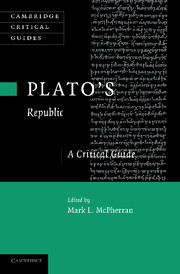Book contents
- Frontmatter
- Contents
- Acknowledgments
- List of contributors
- List of abbreviations
- Introduction
- 1 Socrates in the Republic
- 2 Platonic ring-composition and Republic 10
- 3 The Atlantis story: the Republic and the Timaeus
- 4 Ethics and politics in Socrates' defense of justice
- 5 Return to the cave
- 6 Degenerate regimes in Plato's Republic
- 7 Virtue, luck, and choice at the end of the Republic
- 8 Plato's divided soul
- 9 The meaning of “saphēneia” in Plato's Divided Line
- 10 Plato's philosophical method in the Republic: the Divided Line (510b–511d)
- 11 Blindness and reorientation: education and the acquisition of knowledge in the Republic
- 12 Music all pow'rful
- Bibliography
- Index of passages
- Index of names and subjects
9 - The meaning of “saphēneia” in Plato's Divided Line
Published online by Cambridge University Press: 04 February 2011
- Frontmatter
- Contents
- Acknowledgments
- List of contributors
- List of abbreviations
- Introduction
- 1 Socrates in the Republic
- 2 Platonic ring-composition and Republic 10
- 3 The Atlantis story: the Republic and the Timaeus
- 4 Ethics and politics in Socrates' defense of justice
- 5 Return to the cave
- 6 Degenerate regimes in Plato's Republic
- 7 Virtue, luck, and choice at the end of the Republic
- 8 Plato's divided soul
- 9 The meaning of “saphēneia” in Plato's Divided Line
- 10 Plato's philosophical method in the Republic: the Divided Line (510b–511d)
- 11 Blindness and reorientation: education and the acquisition of knowledge in the Republic
- 12 Music all pow'rful
- Bibliography
- Index of passages
- Index of names and subjects
Summary
Plato's famous comparison of the different forms of human awareness with a line divided into four parts contains many puzzling features. Among the most enduring of these have been whether each of the forms of awareness has its own set of objects (and if so, what objects correspond with dianoia or “understanding”); whether the line extends in a horizontal, vertical, or even diagonal direction; whether the equal length of the line's central segments is a matter or some importance or an unintended, perhaps even irrelevant, consequence of the proportions assigned to the other segments; and whether the line merely identifies the various possible forms of awareness or describes a multi-stage process through which each learner must pass on the way to full comprehension. In this essay I touch on some of these questions, but my main aim is to make sense of what I regard as Socrates' most puzzling claim, namely that the different line segments provide a measure of the relative degrees of saphēneia and asapheia – usually translated into English as “clarity” and “obscurity” – available to human beings. I will argue that none of the usual translations of saphēneia provides us with a satisfactory understanding of this remark. I then review the use of saphēs and its cognates from the time of the Homeric poems down to the fourth century bce and argue that the relevant sense of saphēneia in this setting is “full, accurate and sure awareness of an object.”
- Type
- Chapter
- Information
- Plato's 'Republic'A Critical Guide, pp. 171 - 187Publisher: Cambridge University PressPrint publication year: 2010



